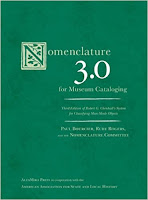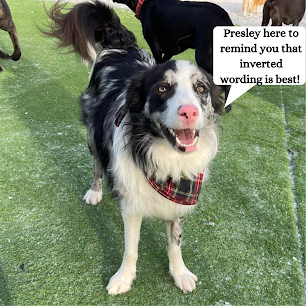Inverted vs Natural Order
There is no doubt that Robert G. Chenhall left a lasting legacy for museums throughout North America when in 1978 he created “Nomenclature for Museum Cataloging: A System for Classifying Man-Made Objects”. As museum workers, volunteers, or even summer students we have probably either used this or an iteration of it at some point to catalogue an artifact. According to nomenclature.info: “Nomenclature is the most extensively used museum classification and controlled vocabulary for historical and ethnological collections in North America."
 One aspect of nomenclature that we are all familiar with is how object terms are listed in the inverted order (Blade, Skate for example). Did you know that one of the primary reasons for inverted order was to help group similar objects in the index of printed books like Nomenclature 3.0 and 4.0? A move to an online (and free) format has made nomenclature much more accessible to museums and still very easily searchable. With a number of reasons listed on the nomenclature.info website however, there was an announcement made in September 2020 that implied they wanted us to switch from the inverted order to the natural order (Skate, Blade for example). With this announcement came panic and a moment of grief for A LOT of museum folk. For me it left me with thoughts of “how am I going to find the time to change over 5000 records?” While this post seems to have taken a turn from “wow, cool stuff!” to “doom and gloom” there has been another announcement made from CHIN (Canadian Heritage Information Network) backed up by a phone call with Karin stating that using the inverted object term is best and that there is no need to switch object terms in our databases to the natural order. Major sigh of relief. Major.
One aspect of nomenclature that we are all familiar with is how object terms are listed in the inverted order (Blade, Skate for example). Did you know that one of the primary reasons for inverted order was to help group similar objects in the index of printed books like Nomenclature 3.0 and 4.0? A move to an online (and free) format has made nomenclature much more accessible to museums and still very easily searchable. With a number of reasons listed on the nomenclature.info website however, there was an announcement made in September 2020 that implied they wanted us to switch from the inverted order to the natural order (Skate, Blade for example). With this announcement came panic and a moment of grief for A LOT of museum folk. For me it left me with thoughts of “how am I going to find the time to change over 5000 records?” While this post seems to have taken a turn from “wow, cool stuff!” to “doom and gloom” there has been another announcement made from CHIN (Canadian Heritage Information Network) backed up by a phone call with Karin stating that using the inverted object term is best and that there is no need to switch object terms in our databases to the natural order. Major sigh of relief. Major.Now that we've got the important news portion out of the way. Let's take a look at this interesting Chenhall individual. Robert Gene Chenhall was born on January 24, 1923 and died on November 16, 2003 in Albuquerque, New Mexico. Born to Lillian and Raymond Chenhall in Iowa, he had a younger sister, Lila, who was four years younger. Robert (or Bob as he was known) lived an interesting and full life, including serving in WW2 in the US Army Medical Corps. In a 1940 census (check out our NovaMuseEd Conducting a Census Activity) it records him as residing in San Diego, California, where he was completing a Bachelor of Arts degree at San Diego State University. It wasn’t long after that he relocated to Los Angeles where he began working first as a Certified Public Accountant with Price Waterhouse & Co before moving on to other corporate organizations where he would hold positions as corporate controller and chief financial officer.
His obituary states that Chenhall had become “bored with accounting” so he began studying at the Arizona State University where he obtained both a Masters and Ph.D in Archaeology. Chenhall was among one of the first to use computers to catalogue archaeological collections eventually expanding that work into all museum collections. In the 1970s Chenhill was part of the Anthropology Department at the University of Arkansas where he did research for the University Museum and performed field research with the Arkansas Archaeological Survey. After several years Chenhall moved to Rochester, NY where he would play a pivotal role in the development of a cataloguing system for a new museum and then to Buffalo, NY where he would become the Director of the Natural History Museum. From 1980 until his retirement Chenhall would reside in Alburquerque, New Mexico where he worked as the Director of the New Mexico Natural History Museum. Throughout his working career Chenhall travelled internationally helping museums computerize their collections and continued on in post-retirement acting as a consultant for museums in New Mexico.With that comes the end of this post. Remember INVERTED WORDING IS BEST! Keep up with the great work that you’ve been doing (seriously take a look at those numbers in our January 2022 Update) and on that joyous note: happy cataloguing.


No comments:
Post a Comment